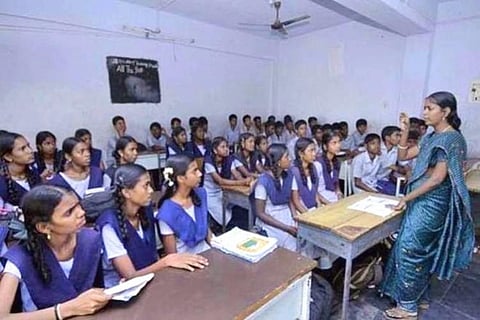

As academics, student organisations, political leaders and social media enthusiasts across India debate the National Education Policy document, one aspect that needs elaboration is why everyone needs to look at Tamil Nadu’s leadership status in higher education.
Going by sheer record and statistics, the Union Education Ministry should simply take inputs from Tamil Nadu or follow its example to achieve at least some of the targets that the government has set for itself under NEP 2020.
Let’s look at one ambitious target the NEP has set for the country:
Reaching a gross enrolment ratio (GER) of 50% by the year 2035 in higher education. (GER here refers to the number of youths in 17–24 years’ age group studying in higher education institutions in India, as a proportion of the overall population in that age group).
In other words, the government wants to ensure that 50% of the youth aged between 17 and 24 years should be studying in higher educational institutions in the next 15 years.
Tamil Nadu reached 49.2% in the year 2018! In other words, TN is a clear 17 years ahead of the rest in the country. This is the result of several factors. Tamil Nadu’s proactive policies in terms of nutritious meals scheme for all school children has led to 99% enrolment in school education. The State gives the highest priority to school education in budgetary allocations and this has helped it near 100% enrolment in school education.
Tamil Nadu’s 69% reservation for OBC and other backward sections, special and inclusive reservation agenda in the form of sub-reservation for OBC Muslim and the Arundhatiar sects, a distinct grouping among Scheduled Castes, made every school-going child aspire for higher education. Tamil Nadu has been a leader in implementation of the Sarva Shiksha Abhiyan, which also ensured that more students complete education up to Class X. Again, the huge number of government-aided and private schools provides a large platform for a majority of Class X passing crowd to enter higher secondary education.
A classic example of the state’s developmental agenda as seen in the last three decades is the sheer availability of institutions for aspiring youth.
- 31 government-funded or aided medical colleges with 2800 seats (2nd highest in India)
- 550 engineering colleges that offer BE/B.Tech/Architecture programmes (highest in India), as per AICTE statistics
- 450 polytechnics (diploma level engineering programmes) as per AICTE.
- 1543 arts/science / humanities colleges
- 21 Universities
Not to mention a dozen deemed-to-be universities that offer a range of programmes in all disciplines, besides private institutions that offer a plethora of skilling courses for aspirational youth.
Recently, the Union Ministry of Education released the results of the National Institutional Ranking Framework (NIRF) for 2020. The most striking aspect of the final rankings is that Tamil Nadu has the highest number of Institutions in the Top 100 in India. The State is also in the top 3, among institutions with high grading (3.0 plus upon 4) under the quality parameters of the National Assessment and Accreditation Council (NAAC). More than 700 institutions (colleges and Universities) have undergone NAAC’s gruelling accreditation process and come out successful.
All these, one should concede, is the result of sustained efforts by political leaders of the Dravidian parties such as C N Annadurai, M Karunanidhi, M.G Ramachandran, J Jayalalithaa, who provided thrust to both social justice and economic growth agenda.
Two biggest outcomes of this sustained and politically backed development agenda of Tamil Nadu, are the quantum of student success and their contribution to economic growth.
Tamil Nadu is indeed a fine example of investment in education. Successive progressive regimes have had a big impact on job growth. Statistics put out repeatedly by large corporates show that Tamil Nadu is among the top 3 states contributing to the entire job market in India (along with Maharashtra, NCR and Karnataka). In engineering college placements across India, Tamil Nadu is still the leader.
From an economic growth perspective too, the State’s education agenda seems to be paying off quite well. With a GDP of over Rs 18.54 lakh cr, Tamil Nadu is India’s second biggest economy – only behind Maharashtra and ahead of Gujarat, Karnataka or other states.
Even here, Gujarat economic activity is skewed. Over 60% of the GSDP contribution is from the core industry while agriculture contributes hardly 10% of its economic activity. The services sector’s contribution is about 37%.
However, Tamil Nadu has a more balanced plate. Agriculture contributes to about 7% of the state’s GDP, the core manufacturing sector contributes 36% and the growing services sector forms the rest 57%.
Several politicians and academics in the state have taken to social media to put all these points in perspective. In a representation to the Union Education Minister, Viduthalai Chiruthaigal Katchi (VCK) leaders have noted that states should have been involved more in formulating the new NEP 2020.
Tamil Nadu’s experiments in social justice and equity, its welfare orientation, high quality investments into creating educational infrastructure, and an enabling ecosystem that encourages private sector participation in school, higher and tertiary education have all borne enough fruit. This could be the beacon for not only other states to follow, but perhaps be the guiding star for the Union Government as it navigates into a 15-year journey with ambitious targets under NEP 2020.
K Ramachandran is the Chief Strategy Officer of www.361dm.com